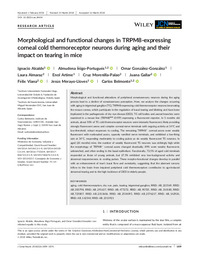Título :
Morphological and functional changes in TRPM8-expressing corneal cold thermoreceptor neurons during aging and their impact on tearing in mice |
Autor :
Alcalde, Ignacio
Iñigo Portugués, Almudena
González González, Omar
Almaraz, Laura
Artime, Enol
Morenilla Palao, María Cruz
Gallar, Juana 
Viana De la Iglesia, Félix
Merayo Lloves, Jesús
Belmonte Martínez, Carlos |
Departamento:
Departamentos de la UMH::Fisiología |
Fecha de publicación:
2018-03-16 |
URI :
http://hdl.handle.net/11000/5230 |
Resumen :
Morphological and functional alterations of peripheral somatosensory neurons during the aging
process lead to a decline of somatosensory perception. Here, we analyze the changes occurring
with aging in trigeminal ganglion (TG), TRPM8-expressing cold thermoreceptor neurons innervating
the mouse cornea, which participate in the regulation of basal tearing and blinking and have been
implicated in the pathogenesis of dry eye disease (DED). TG cell bodies and axonal branches were
examined in a mouse line (TRPM8BAC-EYFP) expressing a fluorescent reporter. In 3 months old
animals, about 50% of TG cold thermoreceptor neurons were intensely fluorescent, likely providing
strongly fluorescent axons and complex corneal nerve terminals with ongoing activity at 348C and
low-threshold, robust responses to cooling. The remaining TRPM81 corneal axons were weakly
fluorescent with nonbeaded axons, sparsely ramified nerve terminals, and exhibited a low-firing
rate at 348C, responding moderately to cooling pulses as do weakly fluorescent TG neurons. In
aged (24 months) mice, the number of weakly fluorescent TG neurons was strikingly high while
the morphology of TRPM81 corneal axons changed drastically; 89% were weakly fluorescent,
unbranched, and often ending in the basal epithelium. Functionally, 72.5% of aged cold terminals
responded as those of young animals, but 27.5% exhibited very low-background activity and
abnormal responsiveness to cooling pulses. These morpho-functional changes develop in parallel
with an enhancement of tear’s basal flow and osmolarity, suggesting that the aberrant sensory
inflow to the brain from impaired peripheral cold thermoreceptors contributes to age-induced
abnormal tearing and to the high incidence of DED in elderly people.
|
Palabras clave/Materias:
aging
cold thermoreceptors
dry eye
pain
tearing
trigeminal ganglion |
Área de conocimiento :
Fisiología |
Tipo de documento :
info:eu-repo/semantics/article |
Derechos de acceso:
info:eu-repo/semantics/openAccess |
DOI :
https://doi.org/10.1002/cne.24454 |
Aparece en las colecciones:
Artículos Fisiología
|
 La licencia se describe como: Atribución-NonComercial-NoDerivada 4.0 Internacional.
La licencia se describe como: Atribución-NonComercial-NoDerivada 4.0 Internacional.
.png)
